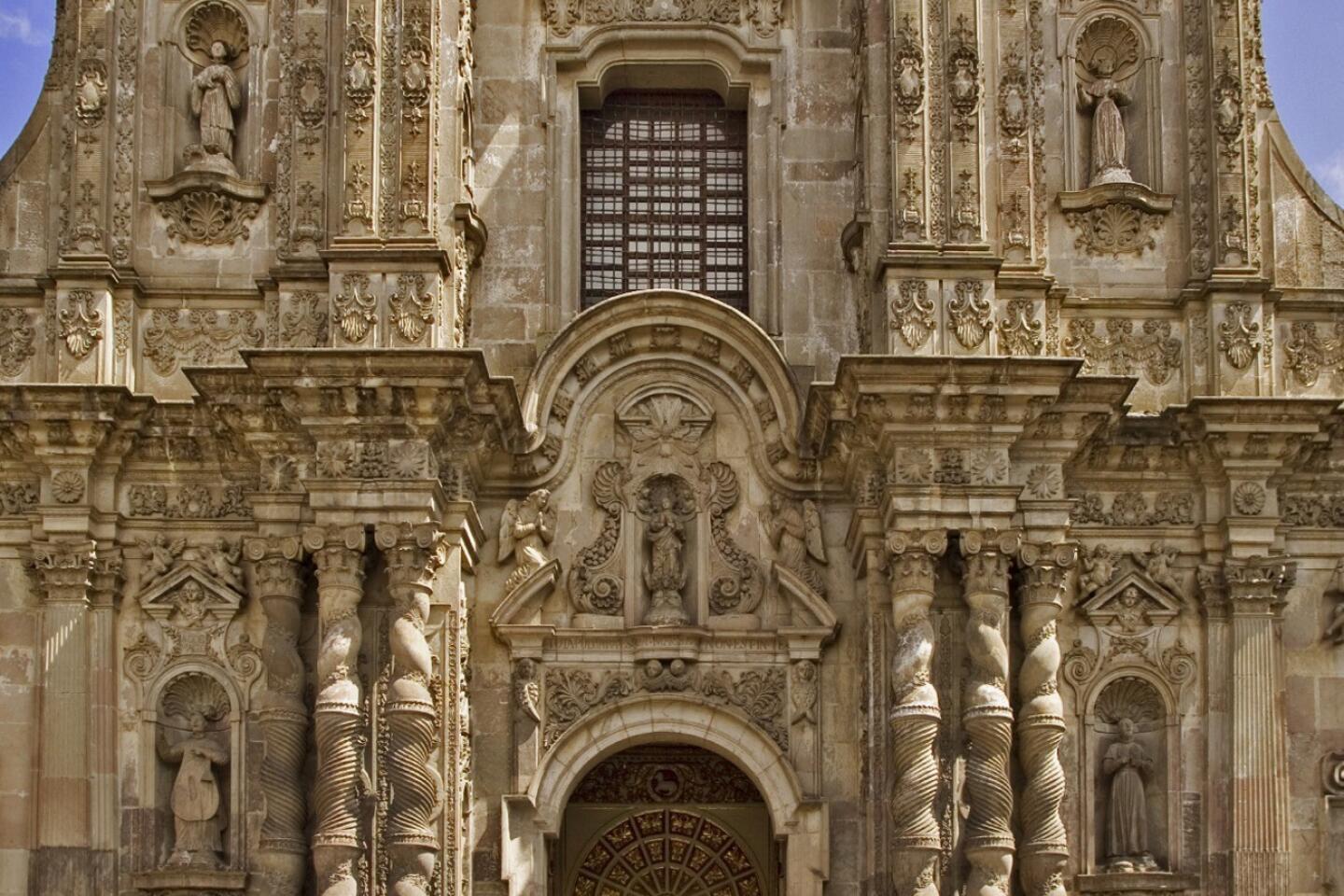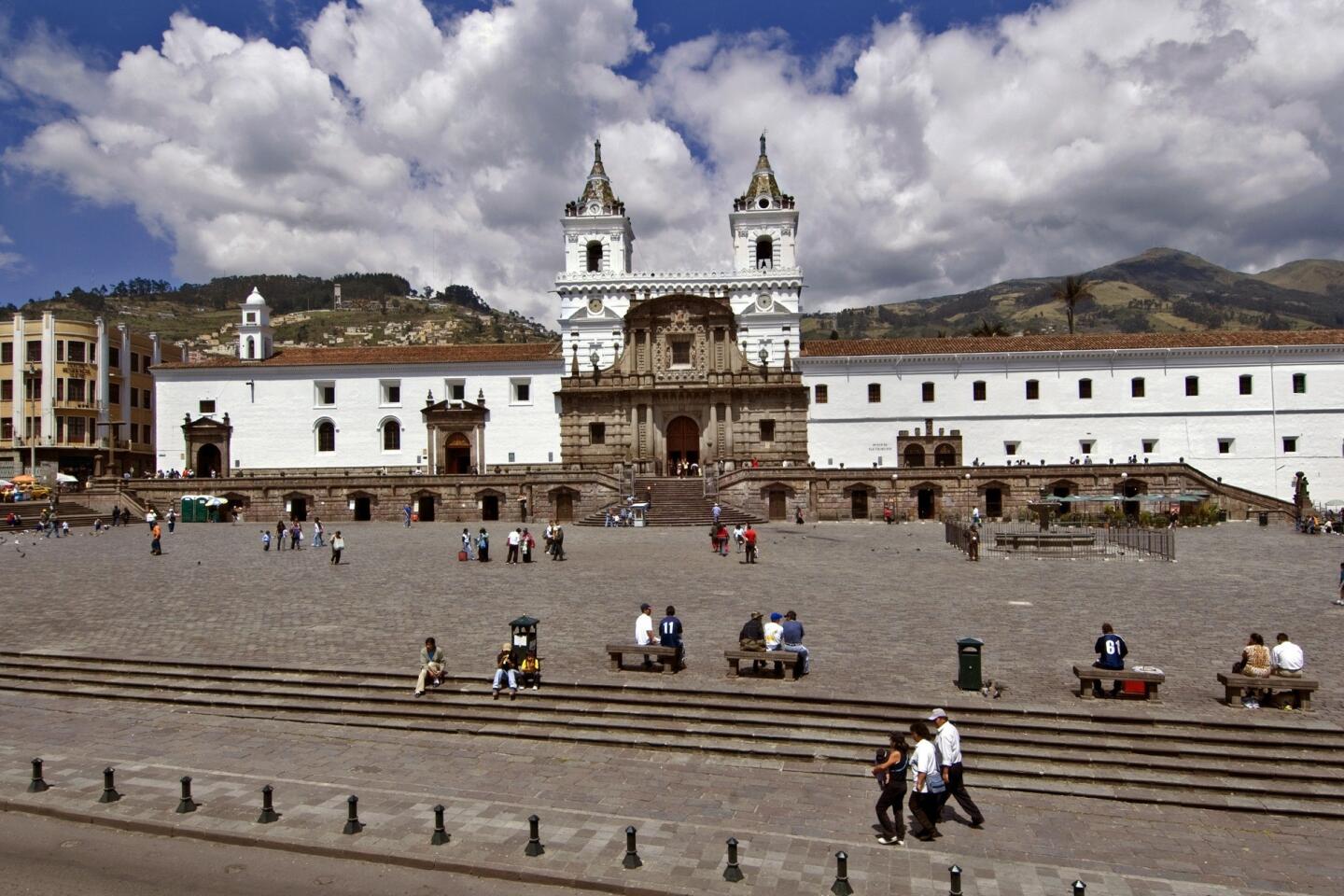The charms of Old Quito, Ecuador
- Share via
QUITO, Ecuador — “Not long ago, we wouldn’t think of coming to this area,” Dominic Hamilton tells me as we stand on a street corner in Quito’s historic area at 1 a.m. “It was horribly seedy. And dangerous.”
Hamilton is a Brit who, after having spent many years writing guidebooks on South America, fell for an Ecuadorean woman and her country and made a life here. That was nine years ago.
“Old Quito is one of the most beautiful cities in the world,” he continues. “But it had become a shabby shadow of its former self — with drug dealers, thieves and other illicit industries. Street peddlers had taken over the plazas. It took 20 years of planning and over $250 million to reclaim this part of the city and begin to restore it. An amazing feat.”
In 1978, UNESCO named Quito, along with Krakow, Poland, the first two World Heritage Cities. Quito is the largest and most historically preserved of all of Latin America’s colonial cities, but the town did nothing but go downhill until some politicians and a few prosperous businessmen decided it was time to bring it back.
Nowadays, the historic center is en fuego with energy. Tourists are staying longer than the obligatory one night en route to the Galápagos or the Amazon, and locals, who have moved into restored 17th century mansions, and suburbanites are coming to experience theater and music performances or dine at the burgeoning number of chic restaurants.
Earlier in the evening, Hamilton and I had eaten in La Ronda, an area he was determined to show me. “This street used to be the worst of the worst,” he says. “It was just above the train station, and it was a red-light district.”
Now the cobblestone pedestrian street wends up the hill lined with flower-hung, whitewashed buildings housing hip bars, nightclubs, art galleries and coffee houses. We’d dined at La Primera Casa, a restaurant in an old adobe on La Ronda serving traditional Ecuadorean food among modern quiteño art.
In a corner, a band played pasillo music, and we drank cinnamon canelazo, a local Andean hot toddy, while we ate empanadas and langoustines in garlic butter. Afterward, we caught a cab to La Mariscal, the neighborhood northeast of the Centro Histórico, to Seseribó, an underground salsa club where locals shimmied and swiveled on the dance floor.
In the wee hours, Hamilton dropped me at Casa Gangotena, a new hotel and possibly the boldest move yet in Quito tourism. It’s set on a prime location on the Plaza de San Francisco, an area previously so thick with vendors’ stalls that it was impossible to see its beauty. In 2002, the government built a covered market for these “informal sector” vendors and relocated them. It upped the police presence downtown and drove out crime.
Gangotena, formerly the home of a wealthy 1920s merchant of the same name, was purchased by one of Ecuador’s largest tourism companies, which, determined to see Quito revived, transformed the ruined mansion into a 31-room boutique hotel that opened in 2011. The building kept its grand aspect, with soaring tin ceilings, cavernous rooms, marble floors and frescoed walls, but the modern-classic furnishings and avant-garde palette are most certainly this century. The same company also opened the wondrous Mashpi Lodge, a 21/2 -hour drive out of Quito in the Andean cloud forest.
There are so many historic churches and cathedrals in Quito that you could make an entire trip out of houses of worship, such as the gilded La Compañia, the simpler Santo Domingo, the Baroque San Francisco and the Gothic Basilica, among scores of others.
These days, however, Quito’s cultural life thrives as the religious one once did. Almost nightly there is an event in one of the city’s plazas — a concert, a dance, a choir performance, a speech, a play or a political rally. In addition, there is an extraordinary number of excellent restaurants with food unlike anywhere else in South America.
Blessed with a fecund land producing exotic fruits and vegetables, an ocean of fish and a refined European influence, Ecuadorean cuisine is imaginative and farm-to-fork fresh. I was here just before Easter, when fanesca, the traditional Easter soup, was being served.
This heavy, stew-like potage made from 12 grains representing the 12 apostles has no on recipe, I discovered. Every cook has her secret version, and it appeared that the town was having a fanesca cook-off, comparing one household or restaurant’s recipe to another.
After sampling Quito’s eating establishments, I decided the restaurant at Casa Gangotena had the best food and most certainly the best fanesca (the general manager’s great-grandmother’s recipe). One evening, I slunk into the empty restaurant for dinner at the shockingly early hour of 7:30. (Ecuadoreans generally start showing up at restaurants around 9 p.m.)
After my meal, Gangotena’s chef (who had worked in the States) bounded out of the kitchen to give me an impromptu chocolate tasting. I learned that I have spent a long life eating inferior chocolate that has little cocoa and a lot of vegetable oil. Oh, the betrayal. Ecuadorean chocolate, however, is the real deal.
I tasted 100% pure dark, which means it is all cocoa, no sugar, and was too bitter; 90% cocoa, which also was too bitter; 82% cocoa, which was perfect; 70%, which was also perfect; and 50%, which, to my newly discerning palate, was less perfect.
Then I indulged in hot chocolate made of 82% Pacari organic chocolate melted with steamed milk. Bliss in a cup.
Between consuming high-calorie food, I toured several museums. My favorite, Casa del Alabado, is a small, sleekly designed pre-Columbian art museum within a renovated historic villa. With 5,000 pieces from ancient cultures that lived within the borders of Ecuador, it is a must, even if you don’t like art.
After wandering the peaceful rooms of the Alabado, I explored the town’s crowded back streets. I was ogling chicken feet in a food market when I noticed a small stall advertising Señora Rosa Lagla’s limpia treatments, cura el espanto, or cure for fright or terror. Limpia is the traditional Ecuadorean herbal treatment for maladies both mental and physical, the idea being that it rids the body of negative energy and restores equilibrium.
Because I’m a chump for all things involving traditional healing, I asked if she would treat me, but, looking at the curtained changing booth in which she performed her cures, I requested she come to the hotel. Of course, she told me, she treats guests at the Gangotena all the time. This news surprised but bolstered me, and I made an appointment for the next day.
The diminutive Señora Rosa bustled in at the appointed hour carrying bushels of herbs, flowers and an egg. I stripped to my underwear in the bathroom and stood before her as she briskly set about whacking me with stinging nettles to chase out negative energy. This, unsurprisingly, stung.
Then she whacked me with laurel, mint, yerba buena and other assorted herbs, which immediately took away the sting. After several more herbaceous floggings, she took a whole egg, surrounded it with rose petals, and rubbed it all over my body, still intact. This was to remove any nasty energy the nettles had missed.
Thirty minutes and $40 later she was gone, and I was left with glowing skin and a thoroughly purified psyche.
The following morning, my reinvigorated spirit and I took to the streets, stopping by the Escuela Taller Quito, a school for underprivileged youngsters who are taught trades such as woodcarving, painting, restoration or sewing. Their work was staggering, especially the furniture rendered in the original, painstaking Spanish style. The student gallery (where museum-quality pieces were for sale) had inlaid writing desks complete with elaborate hidden compartments.
It would be remiss to visit Quito and not step on the equator, so I caught a cab and went to the Intiñan Equator Museum, a touristy “village” that happens to be lots of fun. Besides reenactments of early indigenous life, the museum conducts experiments that are mighty convincing when you are participating in them. For example, when standing smack on the equator, I could not pry apart the fingers of a fellow visitor, but I could easily do so when standing 3 feet to the side.
I also could not walk a straight line blindfolded; had it been a DUI test, I would have been thrown in the slammer. Water goes straight down a drain instead of circling, and you can balance an egg on the end of a nail with ease. All enjoyable and you get your passport stamped at the end. Who wants to miss that?
Dominic Hamilton looked skeptical when I told him the results of the experiments. “Why?” I asked him. He said with a shrug, “Oh, it’s all part of the magic of Quito, I suppose.”
More to Read
Sign up for The Wild
We’ll help you find the best places to hike, bike and run, as well as the perfect silent spots for meditation and yoga.
You may occasionally receive promotional content from the Los Angeles Times.









